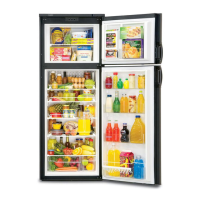7
STORAGE COMPARTMENTS
FOOD STORAGE COMPARTMENT
• Cool the refrigerator before placing any food inside.
Never put hot food or drinks into the refrigerator - cool
them rst.
• The food storage compartment is completely closed and
unventilated, which is necessary to maintain the required
low temperature for food storage. Consequently, foods
having a strong odor or those that absorb odors easily
should be covered.
• Vegetables, salads, etc. should be covered to retain
their crispness.
• The coldest positions in the refrigerator are under the
cooling ns and at the bottom of the refrigerator. The
warmer areas are on the upper door shelves. This should
be considered when placing different types of food in
the refrigerator.
• Arrange all food in the unit to allow for free air circulation.
Do not overpack because a stuffed refrigerator must
work harder and will have higher cabinet temperatures.
• Do not leave the unit’s door open any longer than neces-
sary. This will reduce frost formation and increase the
efciency of the refrigerator.
FROZEN FOOD STORAGE
COMPARTMENT
This compartment is not designed for deep or quick freez-
ing of food.
• To prevent food from drying out, keep it in covered dish-
es, containers, plastic bags or wrapped in aluminum foil.
• Meat or sh, whether raw or prepared, can be stored
in the frozen food storage compartment provided they
are precooled rst in the refrigerator. They can be stored
about three times longer in the frozen food compartment
as compared to the fresh food compartment.
• Quick frozen soft fruits and ice cream should be placed
in the coldest part of the compartment, which is at the
bottom of the aluminum liner.
• Frozen vegetables, may be stored in any part of the
compartment.
• To prevent frost buildup, which can reduce efciency,
wipe excess moisture off items being placed in the
compartment.
ICE CUBES
Ice cubes can be made in the freezer compartment. For
faster freezing, place trays in direct contact with the bottom
of the freezer compartment. Ice will be made more rapidly
if the thermostat is set at its highest position, but be sure to
move the thermostat back to normal setting when the ice is
formed; the refrigerator might otherwise become too cold.
REFRIGERATOR VOLUME
REFRIGERATOR
MODEL
TOTAL REFRIGERATED
VOLUME (CU. FT.)
RM3762 7
RM3962 9
FIRE OR EXPLOSION HAZARD. Do not store
or use gasoline, oil or gasoline soaked rags,
or other ammable vapors and liquids in the
service area behind the refrigerator or in the
vicinity of this or any other gas appliance.
Failure to obey this warning could cause a
re or an explosion resulting in death or seri-
ous injury.
INSTRUCTIONS FOR USE
TURNING OFF THE REFRIGERATOR,
AND WHEN IT IS NOT IN USE
You can turn off your refrigerator by pressing the main
power ON/OFF button found on the control panel to the
off position. This will shut off all power to the refrigerator,
including DC power.
If the refrigerator will not be in operation for an extended
period of time or put into winter storage, it should be emp-
tied, defrosted, cleaned, and the doors placed in the airing
position. If ice cube trays are in use, they should also be
dried and kept outside the cabinet.
The refrigerator’s control system still consumes a
few milliamps even if it is turned off. If your RV is
being put into winter storage, it is recommended to
either put your RV batteries on a battery charger or
turn off the vehicle’s main 12 VDC switch. This will
prevent the RV battery from discharging.
This refrigerator is intended for continuous
use. Do not allow it to run unattended when
there is a risk for loss of electricity or fuel.
Food spoilage could occur.

